Top 6 Must-Know Facts To Maintain Your Pool At Home

When you own a swimming pool, you already know that you have to constantly maintain it to ensure that you and your family can continue to enjoy the pool in its best condition.
However, many people underestimate the need to keep your pool clean, while some are not aware of how to do it.
It is very important to maintain your pool in the right way to keep it in top condition all year round. To make this job easier, this article will let you understand the must-know facts to maintain your pool at home with the following tips.
1. Cleaning Manually
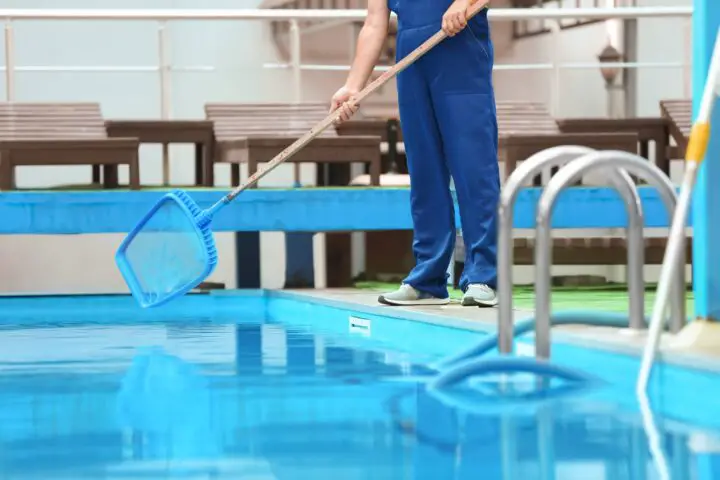
If possible, try to manually clean the pool every day. Use cleaners, brushes, and debris-catching devices for removing the dirt floating on the surface. If there are too many branches or leaves, you can use a robot cleaner. Click roboticpoolcleaner.org to know more about it.
To remove the unwanted substances, brush the walls and clean the build-up stuck to the porous concrete or fiberglass of your pool. You can do this job weekly and just before you vacuum. When you are done brushing the surfaces, the particles will be ready to sink to the bottom and get vacuumed.
2. Skimming

When skimming your pool, remember to keep the pool’s water from 1/3 to 1/2 way up the opening. At this level, your pool operates best. Using a pool skimmer will help attract the surface water of your pool while pulling in small debris that might have fallen in.
When the water level is too low or too high for the skimmer, a few inconvenient, as well as potentially damaging things, may happen. The water might move too slowly into the skimmer when your swimming water level is too high. This can cause debris to bypass the skimmer and get stored in the pool.
When the water level is too low in your pool, the skimmer will not have enough to suck in. As it might bottom out it may suck in air instead, which can result in burning the pool’s motor pump.
3. Raking and Vacuuming
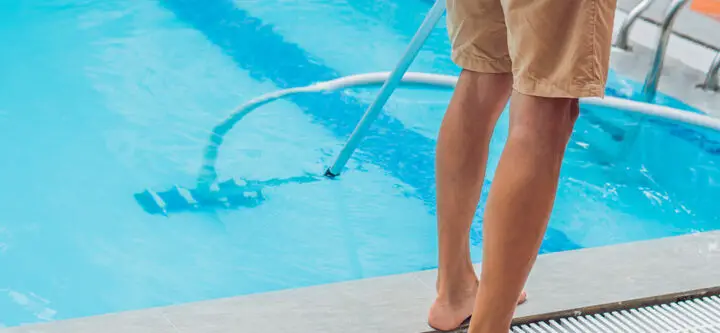
You might like to use a rake or net for scooping out debris such as twigs, leaves, and branches. You can easily access all areas of the pool by investing in a sturdy scoop that features a lightweight design and an extra-wide net with a telescopic pole.
Pour in water before you backwash and vacuum. The water level decreases due to the vacuum which is why you have to add water beforehand. It will help you to remove dirt and other debris that has fallen to the bottom of your pool. Rake, vacuum, and clean your pool every week to get the best result.
Filtration Systems
There are three main filtration types:
- Sand Filters: These filters are made of fiberglass, metal, or concrete. It contains a solid bed of specific sand which does the job of trapping dirt and debris. You need to change the sand every five years to keep it working fine.
- Cartridge Filters: These filters usually allow water to seep through a good filtrating surface. This type can contain the impurities inside it until you clean it. It might be recommended over the sand ones as they have a bigger surface area. You need to replace it every three to five years.
- Diatomaceous Earth Filters: These types of filters contain porous bone material to filter the debris. You can install it quite simply, as you only have to place it directly into the skimmer. You need to backwash and replace it once or twice a year.
Always remember that the pool filters are some of the most crucial tools for the pool. So, make sure you are keeping them clean and maintaining a proper care routine.
Applying Chemicals To the Pool
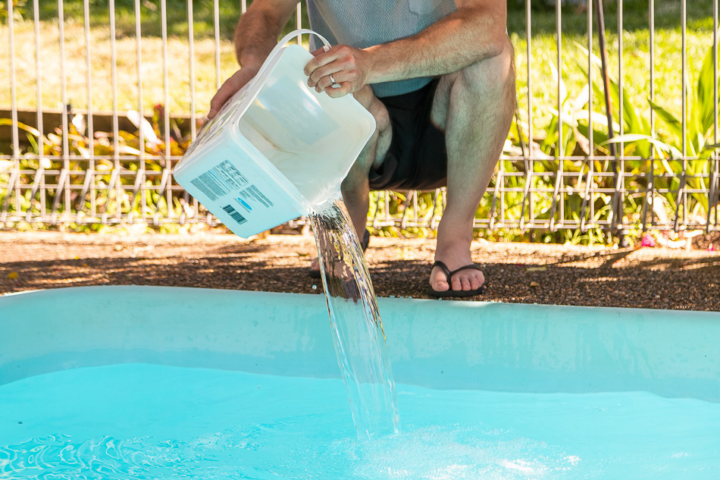
To maintain your pool properly, you need to add some specific chemicals in the right quantity.
From time to time, you might face various water issues that will require aggressive chemical solutions. But generally, some chemicals need to become part of the pool maintenance routine.
Stick to the product’s instructions for appropriate dosage and adjust when necessary. The most common chemicals you might need are chlorine, shocking products, and algaecide.
Applying Chlorine to Your Pool
No one wants to swim along with algae and bacteria in the pool. Chlorine can keep these unwanted guests away. You can choose from a list of chlorine products on the market.
Basic Chlorinating Tabs
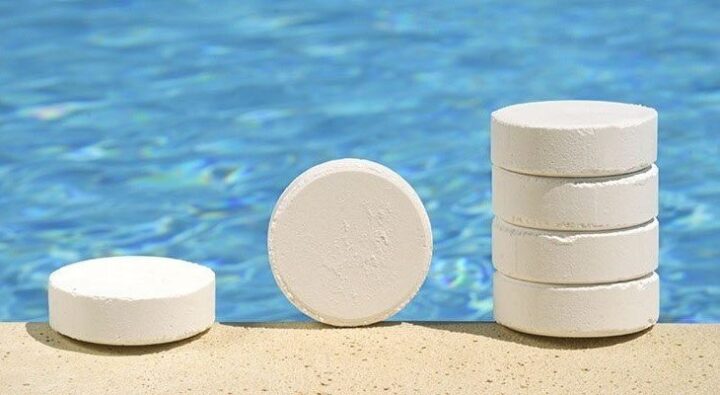
These tabs generally dissolve slowly. You can find them in 1-inch and 3-inch sizes. They are great for keeping your pool clean. Most chlorinating tablets can shield the water’s chlorine from the rays of the sun as they have a built-in stabilizer. You can apply the tablets in your skimmer, floating dispenser, or automatic chlorinator.
Liquid Chlorine
The liquid chlorine is quite similar to your household bleach. But do not forget it is much stronger since it is designed especially for swimming pools. Applying liquid chlorine is easier, but as it has a short shelf life, it might not last for more than a few weeks.
Chlorinating Tabs and Granules
You can use some non-basic chlorinating tabs to maintain your pool using a multifunctional approach. They sanitize the water as well as shock your pool. This helps your pool to remove all sorts of contaminants.
Chlorinating granules have multifunctional applications. It can help you resolve many issues at once such as shocking, killing algae, and chlorinating with a single and daily application.
Shocking Your Pool
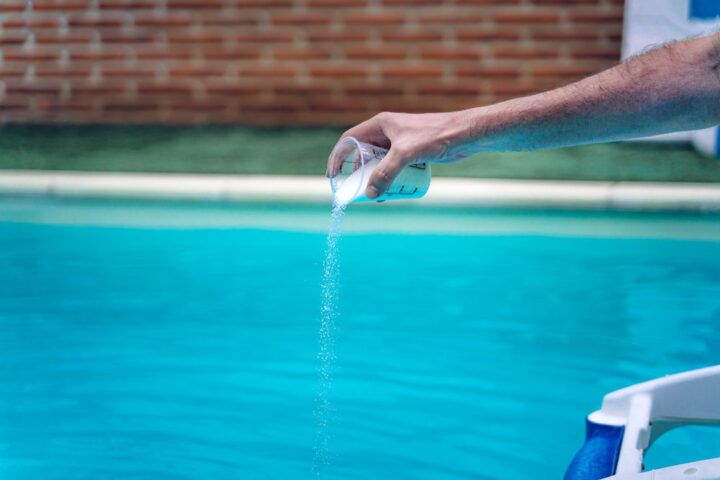
You need to shock your pool to keep the water clear and reduce eye irritation as well as odors coming from the chlorine. As mentioned above, certain chlorine products might already have built-in shockers. But, if you picked one that doesn’t, these are a few shock products you can use to get the job done:
- Basic Shock Products: Basic products can help you in killing bacteria by breaking down suntan lotions, cosmetic residue, and any type of waste from swimmers. Using these products can shock the swimming water and tone down chlorine.
- Multifunctional Shock Products: These kinds of products work faster and restore your water’s clarity and eliminate all types of bacteria.
Multifunctional products boost filtration, balance the pH levels of the pool water, and provide increased algae protection as well. The main advantage of these shocking products is that they allow you to get back into your swimming pool within 15 minutes of applying them.
Adding Algaecide to the Water
There might be millions of microscopic plants that are ready to make your pool their home. Rain, wind, and still water may allow these algae to settle into the pool. It makes the water unusable very quickly as well as diminishes the efficiency of your pool chemicals.
Your filters can get clogged quickly and the water circulation may become sluggish. Algaecides can effectively prevent these tiny plants from threatening the pool. Read the manufacturer’s instructions carefully before pouring the recommended amount of algaecides directly into your pool.
Measuring the pH Value

The pH value helps measure the acidity of your swimming water. As per the principle, lowering the pH value is better for the disinfection of your pool, but remember the value needs to remain healthy for your skin as well.
To maintain an ideal pH value, make sure the swimming water is between 7.2 to 7.6. At a value of 7.0, the water will be neutral. When the water has a higher value it will become basic and at a lower value, the water will turn acidic.
You can easily test the pH value of your swimming pool water by using test strips. The colors on the strip will indicate if the values are correct. When the pH value is too high, this indicates that algae formation, as well as lime deposits, might occur. Additionally, a high pH value in the water will be unhealthy for your eyes and skin. You will then need to add pH minus to lower its value.
Too low a pH value is also bad for your skin and overall health. For instance, you might feel irritation of mucous membranes in the eyes. To make the balance perfect, you will have to add pH-plus to the swimming water. A correct balance is very important to prevent various problems. So, make sure you check your swimming pool regularly using the test strips after reading the provided guidelines.
Final Words
It is important to cover the pool when you and your family are not using it. By covering the pool you are protecting it from insects, dirt, and leaves.
When applying chemicals, make sure to handle them carefully. Some chemicals might be highly dangerous to humans and animals. So, you need to be cautious when applying any chemical solution.
Take proper care of your swimming pool to make it last longer and enjoy it wherever you want.
